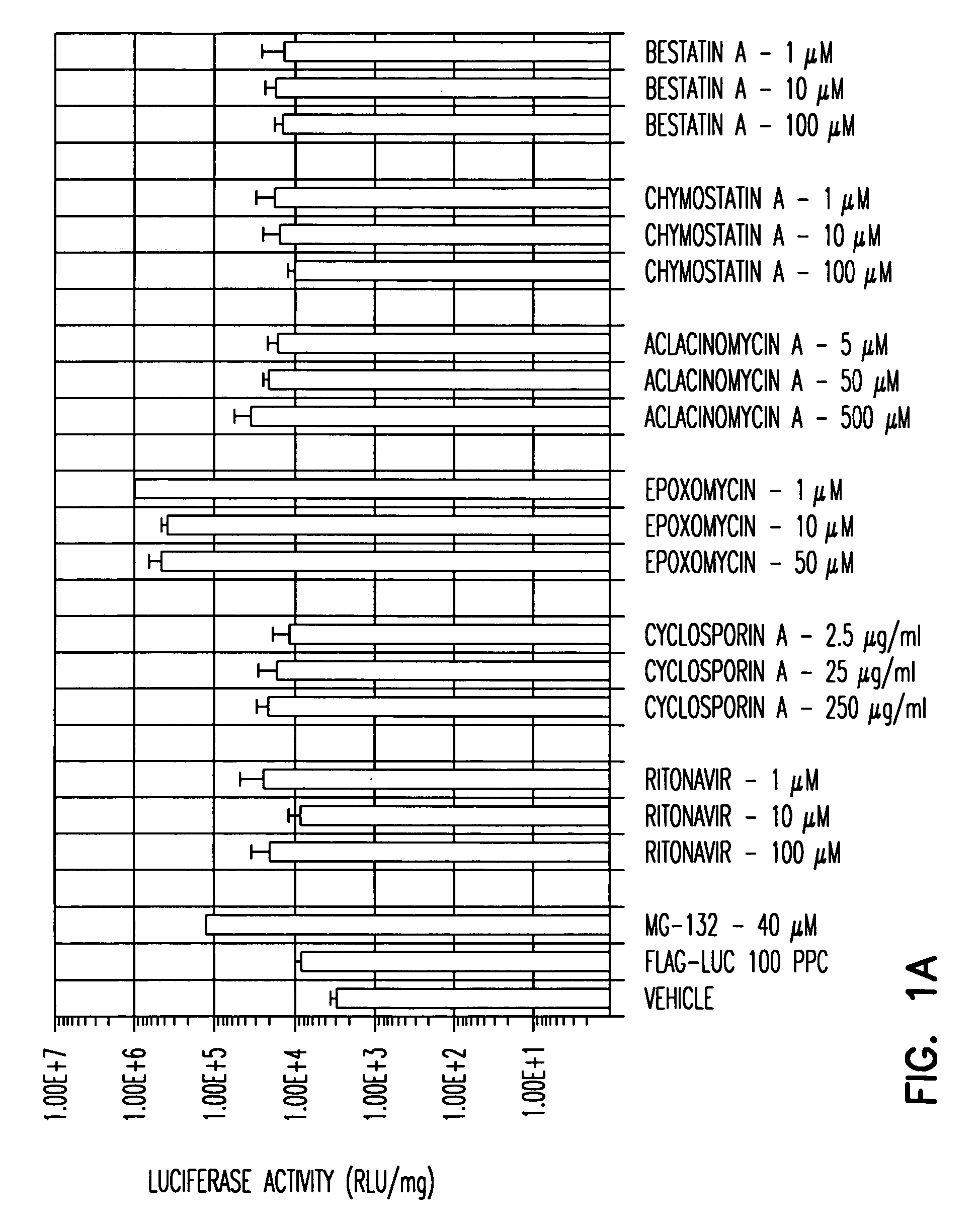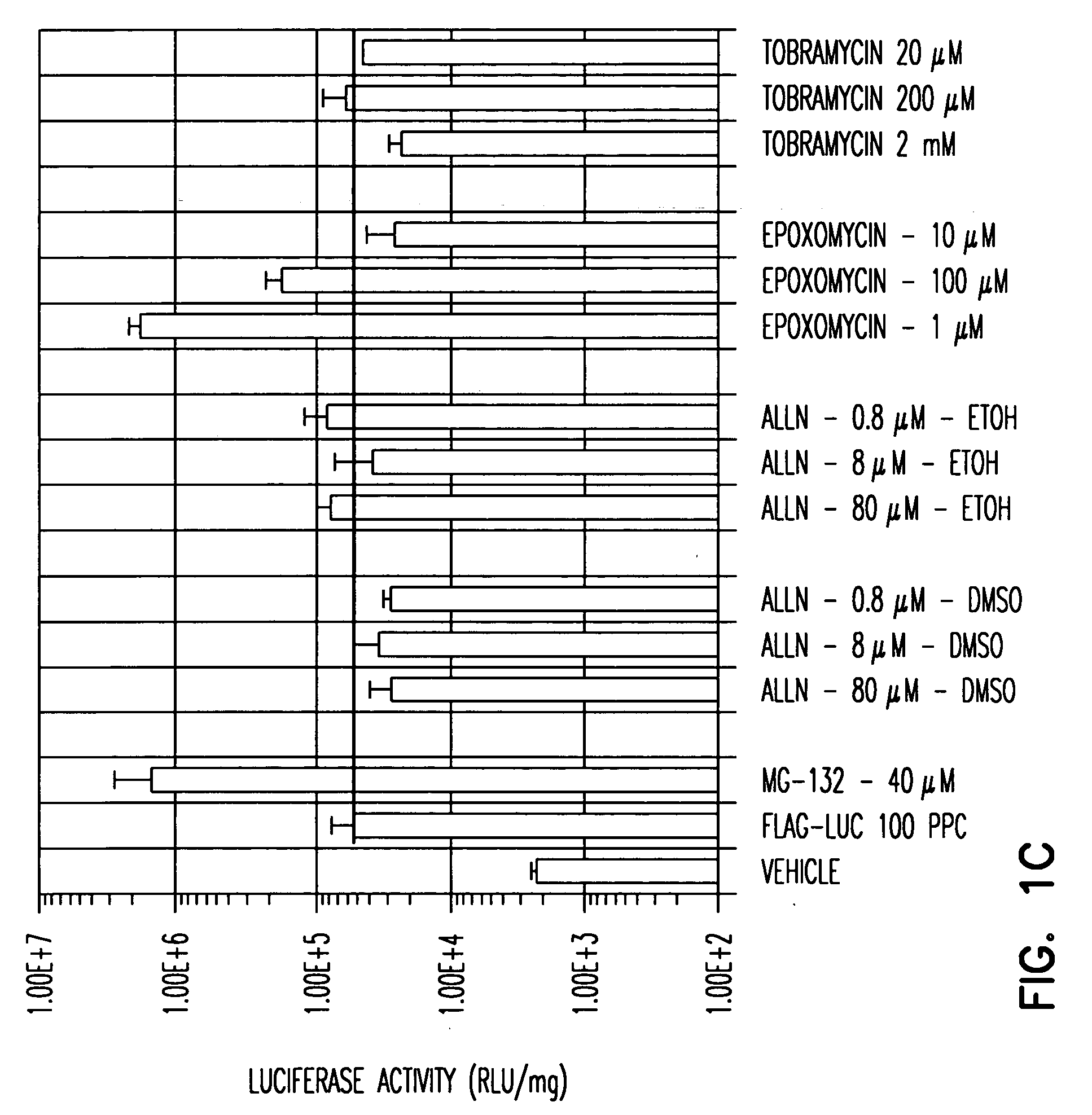Compounds and methods to enhance rAAV transduction
a technology of raav and compound, which is applied in the field of recombinant adenoassociated viruses, can solve the problems of differences in the efficiency of transgene expression in various tissues and cell types, lack of undesirable cellular immune responses, and inability to efficiently cleave at the trs, so as to increase the concatamerization and/or intermolecular recombination of raav, enhance the transduction frequency of raa
- Summary
- Abstract
- Description
- Claims
- Application Information
AI Technical Summary
Benefits of technology
Problems solved by technology
Method used
Image
Examples
example 1
Endosomal Processing Inhibitors May Increase rAAV Transduction in Polarized Airway Cells
Materials and Methods
Primary culture of human bronchial epithelia and reagents utilized. Primary human airway epithelial cells were collected by enzymatic digestion of bronchial samples from lung transplants, as previously described (Kondo et al., 1991; Zabner et al., 1996). Isolated primary airway cells were seeded at a density of 5×105 cells / cm2 onto collagen-coated Millicell-HA culture inserts (Millipore Corp., Bedford, Mass.). Primary cultures were grown at the air-liquid interface for more than 2 weeks, by which time differentiation into a mucociliary epithelium occurs. The culture medium, used to feed only the basolateral side of the cells, contained 49% DMEM, 49% Ham's F12 and 2% Ultraser G (BioSepra, Cedex, France). Dimethyl Sulphoxide (DMSO), camptothecin (Camp), etoposide (Etop), aphidicolin (Aphi), hydroxyurea (HU) and genistein (Geni) were purchased from Sigma (St. Louis, Mo.). Tr...
example 2
Expression of the LacZ Gene in Lung Airway Epithelium and Liver in Vivo
The in vivo activity of rAAV in the presence or absence of an agent of the invention in the lung or liver may be tested using the LacZ gene. A rAAV vector containing the LacZ gene, recombinant AV.LacZ (about 5×1010 particles), was administered to mouse lung either as virus alone in PBS or virus in combination with 40 μM LLnL in PBS. Virus was directly instilled into C57Balb / c mice trachea with a 30 G needle in a total volume of 30 μl. To insure the spread of the virus in mouse lung, 50 μl air was pumped into lung through the same syringe immediately after virus was administrated. Ninety days after infection, lungs were harvested intact and fixed in 4% paraformaldehyde followed by cryosection. AAV-mediated transgene expression was evaluated by 10 μm tissue sections staining for LacZ.
Recombinant AV.LacZ (about 5×1010 particles) was also administered to mouse liver either as virus alone in PBS, virus in combinat...
example 3
Methods to Determine Additional Agents Useful to Enhance rAAV Transduction
A. To screen for agents that enhance rAAV transduction, any number of cells can be used. A range of concentrations of the agent to be tested can be determined based on, for instance desirable profiles of the agent, desirable toxicity profiles of the agent and / or concentration of the agents employed in vivo. The usefulness of the cell type chosen for the screen can be confirmed by testing compounds, e.g., proteosome inhibitors described in Example 1 such as LLnL and ZLL which are known to increase rAAV transduction. For example, a AAV2 FLAG-Luc vector was employed to transduce HeLa, ferret fibroblasts, IB3 and Huh (liver) cells in the presence or absence of the proteosome inhibitor MG132. MG132 was confirmed to enhance AAV transduction in all cell types tested: HeLa cell transduction was enhanced about 500-fold at 80 μM, and 200-fold at 40 μM, MG132; ferret fibroblast cell transduction was enhanced about 200-...
PUM
| Property | Measurement | Unit |
|---|---|---|
| time | aaaaa | aaaaa |
| pH | aaaaa | aaaaa |
| thickness | aaaaa | aaaaa |
Abstract
Description
Claims
Application Information
 Login to View More
Login to View More - R&D
- Intellectual Property
- Life Sciences
- Materials
- Tech Scout
- Unparalleled Data Quality
- Higher Quality Content
- 60% Fewer Hallucinations
Browse by: Latest US Patents, China's latest patents, Technical Efficacy Thesaurus, Application Domain, Technology Topic, Popular Technical Reports.
© 2025 PatSnap. All rights reserved.Legal|Privacy policy|Modern Slavery Act Transparency Statement|Sitemap|About US| Contact US: help@patsnap.com



